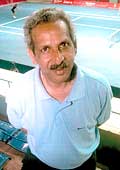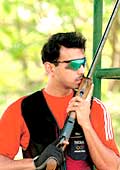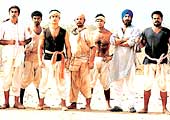 |
| Tomorrow's stars? Kids practise at the
DLTA courts in New Delhi |
$10 billion. Rs 43,000
crore at the then exchange rate. That was the value Fortune magazine
put on hoop-meister Michael Jordan's contribution to the us economy.
It also put him on the cover of the magazine. That was way back
in 1998. Sure, the calculation included sales of clothing and
footwear lines that were either named after or endorsed by the
man, but $10 billion is a lot of money (and 12,192, the number
of baskets Jordan has scored in his lifetime in the NBA, is a
lot of baskets).
The number is significant because it is about
the same value this magazine puts on the size of the sports market
(leaving out sales of products endorsed by sportspeople, but including
pretty much everything else) in India by 2010. That's five years
from now, and if the number still looks like an exercise in inspired
extrapolation (it isn't and is actually based on sound math and
plain common sense) blame it on the Indian psyche. For instance,
were the estimate to be about the size of the offshored Indian
it services industry and were this magazine to say $80 billion
(Rs 3,52,000 crore) by 2010 (the actual number, according to India's
software lobby nasscom will be $48 billion or Rs 2,11,200 crore)
no one would have any problems accepting the number. That's because
India is an it nation. Not a sporting one.
It's one thing to look at the size of a nation's
population and economy and derive the ideal 'sporting-quotient'
for it, something similar to what audit firm PricewaterhouseCoopers
did before the Athens Olympics (the study showed that India should
win 10 medals; see A Sporting Nation...). It is another to realise
that the way Indians look at sports is changing, something that
could eventually result in an Indian winning Wimbledon or earning
a podium-finish in f1, and something that will definitely mean
that the sports economy grows beyond this magazine's Rs 40,000
crore projection by 2010. "In our current culture of consumerism
and self-assuredness, sports are kind of becoming a make-me-feel-good-about-myself
thing," says Santosh Desai, President, McCann Erickson. Sports
is still far from being a way of life in India, unlike in Australia,
where an average household spends upwards of 10 per cent of its
monthly household budget on the pursuit of sports, perhaps every
kind known to man and more. But what is important is that the
very idea of sports in India is morphing from mere entertainment
(huge television audiences) and enchantment (the culture of the
sports celebrity) to also become an attractive activity and indulgence,
if not a serious career option as yet, for the affluent middle
class in India, a good 40 million households across the country.
"Indians are realising the importance of giving their kids
a well-rounded and healthy upbringing and, therefore, you see
lots more kids on tennis courts and more men on golf courses now,"
says Ravi Krishnan, CEO of sports marketing company IMG India.
With obesity amongst middle class Indian kids taking epidemic
proportions, smart parents are pushing their kids towards outdoor
sports as means to expend those extra calories.
THE RS 40,000-CRORE OPPORTUNITY
By 2010, that's how big the Indian
sports economy could be. |
| COACHING: Today,
around 10 million Indians spend an average of Rs 2,000 a month
on tennis, cricket, swimming, squash, or basketball classes
for their children. That's Rs 24,000 crore a year. Even conservatively,
that number would grow to Rs 30,000 crore by 2010
BROADCASTING: Today, sports
broadcasting is a Rs 600-700 crore industry; by 2010, even
if nothing changes, it would be a Rs 1,500-2,000 crore one.
However, pay-per-view, broadband and non-television broadcasting
could change everything and the industry could well be worth
Rs 5,000 crore by 2010
ENDORSEMENTS: A mere Rs
150-200 crore worth today, things will change once India
is represented in the top 10 in the really rich sports,
tennis, say, or golf. Maria Sharapova, for instance, makes
around $20 million (Rs 88 crore) from endorsements. By 2010,
then, this slice of the pie could be worth at least Rs 1,000
crore in India
TICKET SALES: Across sports,
this is an insignificant statistic in India right now. The
English Cricket Board made £5 million (Rs 39.5 crore)
from the sale of tickets for the recently concluded Ashes
2005 test series. If any professional league, either in
football, or hockey, even cricket takes off in India in
the next few years, it would contribute significantly to
revenues from ticket sales
TITLE SPONSORSHIPS: Linked
to the success of a professional league in any sport, this
too, could contribute significantly to revenues
|
| Source: All figures are BT estimates with
inputs from industry players |
Do Economically Developed
Countries Do Better?
It would seem so; should India be happy?
|
| Though sporting
success has a kind of correlation to a country's population
and more so, to economic wealth, the correlation is far from
simple or straight. For it is in fact developed countries,
and those belonging to the former Soviet block and China,
that tend to punch above their weight at most big international
sporting events such as the Olympics. "Sport it seems
is one area where a planned economy can succeed," says
a PricewaterhouseCoopers report (published: 2004), titled
Modelling Olympic Performance. And other unquantifiable invariables,
like relative levels of state and corporate funding, hungriness
for success, attitude and genes play a crucial role. So what
explains India's dismal performance relative to its economy,
for according to the same PwC report, it should have come
home from Athens with 10 medals, not just Rajyavardhan Rathore's
sole silver? "As people, we're not competitive. And till
now the incentives for doing well in sports were minimal,"
says sociologist Ashish Nandy. |
On A Cusp, And Prayer
 |
| Rahul Dravid: #2 today |
"The very idea of earning a living through
sports is alien to us, but it's changing," says sociologist
Ashish Nandy. That's because, as a nation and people we are close
to an inflection point where we are becoming less paranoid with
our concern for the future, partly because a whole new generation
has grown up working in a post liberalised economy. Today, these
individuals are in the 30-45 age group (that would mean they were
15-30 years old when India decided to throw open its economy).
They have benefited from an explosion in livelihood choices and
salaries. They have learned to celebrate consumerism, not denial.
And (thanks to TV) they have watched young Indians falteringly
make their way to the top echelons of their chosen sport. "And
that's when the only-good-education-brings-success-in-life thing
gets to loosen and the feel for nurturing natural talent (in sports,
for instance) rises up the ladder," says McCann's Desai.
| A Career Choice |
 |
| Nike Bhupathi Tennis Village's C.K.G.
Bhupathi: 14 it is |
When do you take the call
to pursue a game you are good at as a career option? According
to C.G.K. Bhupathi, who runs the Nike Bhupathi Tennis Village
on the outskirts of Bangalore (he is the father of Mahesh
Bhupathi, probably the best tennis-doubles player India
has ever produced), the magic age is 14. "From the
age of seven to 14, they train really hard and essentially
pull a double shift almost every day," he says, looking
at a batch of students, "combining the rigours on the
court with their academic requirements." With sports
just beginning to emerge as a viable career option, however,
it still doesn't make sense to focus exclusively on sport
(unless you are very very good or very very rich or, ideally,
both). That's because of the limited opportunities that
exist, says Anirban Blah of Globosport, a sports management
firm promoted by Mahesh Bhupathi. He points to the case
of Shikha Uberoi, ranked 125 in the world and seen as another
rising star, who "continues to struggle in terms of
sponsorship".
-Rahul Sachitanand
|
Not entirely, though. For, although aspirations
and the amount of money people are willing to spend on sports
(typically on lessons for their wards) have soared, infrastructure,
both physical and marketing, haven't kept pace (see The Business
Of Sport). If there are any heroes in this story, it has to be
the parents who perform a variety of roles ranging from sponsor
and cheerleader through ball boy and chauffeur to coach and when
the chips are down, motivational speaker. "My parents have
sacrificed a lot for my sake, right from the time in school when
they had to cart me around for practice to my dad helping with
my finances," says Joshna Chinappa, the world's #2 squash
player in the junior league. And when Aaron D'souza, now all of
13, showed promise in swimming, his father, Agnel D'souza, packed
up everything and moved the family from Mumbai's Thane district
(where full-size pools are non-existent) to Bangalore and the
expert coaching at Basavangudi Aquatic Centre, a place that shot
into limelight when the world discovered that the Millet sisters,
Nisha and Reshma, the brightest stars on India's swimming horizon
for some time, had trained there. "We did well in it because
Indian parents were willing to sacrifice everything to see their
kids succeed in engineering. We are now beginning to see some
kind of societal momentum building up for sports," says Anil
Khanna, Secretary General of All India Tennis Association (AITA).
"I have been in the tennis coaching business for over 17
years now, but the change in parents' and kids' attitude has been
phenomenal over the past one-two years. Now they're coming in
droves. The business for people like me is booming," adds
Shekhar Menon, who runs Shanti Tennis Academy in New Delhi. AITA
has set itself a target of producing 100,000 certified tennis
coaches in the next four-five years, up from under 10,000 currently.
It has also woken up to the fact that hundreds of tennis academies
are mushrooming across the country and is in the process of commissioning
a count to facilitate regulation and promotion.
Cricket Nation
Blinkers or not, our obsession for cricket
is enduring. |
|
It's a simple case of a good
product and great marketing. "Cricket perhaps is the
single largest cultural product consumed in this country,"
says Santosh Desai, President, McCann Erickson. It is also
the single largest builder of our national identity, perhaps
even above our (mutual) animosity with Pakistan.
Little wonder, then sports television rides on Indian
cricket, with over 80 per cent of the total Rs 450 crore
sports advertising spend (2004) going to cricket; in viewership
terms, cricket accounts for 70 per cent of all sports eyeballs.
And cricketers are only celebrities who walk shoulder to
shoulder with film stars, both on popularity and earnings.
"For any sport to become a success, you need icons
whom media can hype," says L.V. Krishnan, Head of television
monitoring agency, TAM. For all the glamour associated with
tennis, and Sania Mirza notwithstanding, can anyone still
think of making a Hindi blockbuster based on any other sport,
but cricket, as Aamir Khan did with Lagaan (left)? This
is something that non-cricket sport federations need to
understand as they set out to promote their disciplines,
something that the Board of Control for Cricket in India
(BCCI) realised a long time ago.
Yet, it is only at the international level that cricket
has any appeal, for players, broadcasters, advertisers and
the like. "BCCI is the richest cricket body in the
world. It can easily support 50-60 academies to tap talent
in small towns and villages," says Navjot Singh Siddhu.
That it can.
-Shailesh Dobhal and Kumarkaushalam
|
Cause And Effect
Everything has a role to play. Broadcasters
and marketers will rush to cover and sponsor events where Indian
sportspeople do well, and, in turn, this coverage and interest
will spur others to take up the sport. Sports broadcasters, such
as ESPN star Sports and Zee Sports, are picking up and repackaging-for-TV
sports such as hockey (Premier Hockey League; see The PHL Experiment)
and football that were once considered too insignificant to cover
in the Indian context. And Sania Mirza's fourth round appearance
against Maria Sharapova at the us Open, says former world billiards
champion Geet Sethi, will "be a big subconscious booster
for a whole generation of Indian tennis players, especially women".
Children Of a lesser God?
Not really, but it isn't quite
cricket. |
 |
 |
 |
| The new ambassadors: Fast,
driven, and on target, but will marketers bite? |
Cricket
still comes in first, but there seems to be a fatigue setting
in for cricketers, and therefore openness for other sports,"
says Latika Khaneja, Director of Collage Sports Management,
on changing corporate attitudes towards sponsoring other
sports. It helps that non-cricket sportspersons, Sania Mirza
(tennis), Arjun Atwal (golf) and Rajyavardhan Rathore (shooting),
are winning international tournaments. Khaneja has already
roped in Sahara and Hero Honda for Rathore, at Rs 75 lakh
a pop, significant numbers even by cricketing standards.
That it isn't always a case of happily-ever-after is evident
from the case of long-jumper Anju Bobby George who is, as
this magazine goes to press, in India, trying to raise some
of the Rs 55-60 lakh she needs to continue to compete in
the international circuit. "Indian companies looking
at going global should sponsor (Indian) golfers in the USPGA,"
says Ravi Krishnan, Managing Director, IMG and TWI for India
and South Asia. That's a thought. After all, if Accenture
can get Tiger Woods for its campaign, why can't Infosys,
TCS, or Wipro sponsor an Atwal or a (Jyoti) Randhawa?
-Amanpreet Singh
|
Read in the larger societal context, the question
of the business popularity of cricket versus other sports, in
terms of broadcast or endorsement money, is actually irrelevant.
"In sports, success and popularity loop into each other,"
says B. Narayanswamy, Director of Indica Research. In cricket
it was India's victory in the Prudential World Cup 1983, and the
presence of icons such as Sunil Gavaskar, Kapil Dev and Sachin
Tendulkar that made the sport an Indian obsession. Such icons
are emerging in other sports now, and, surprise surprise, some
of them are actually going out and winning events.
 |
| Maria Sharapova: Her 2004-Wimbledon
win set off the rush |
"Sania's success, though ephemeral, will
certainly prop up tennis as popular culture," says sports
writer and sociologist Ramchandra Guha. Last year, according to
media monitoring agency tam, the average viewership of a Formula
1 race was 0.1; this year, with India's Narain Karthikeyan in
the fray, the number has increased to 0.3, a jump of 7 lakh households.
"Globally, celebrity and celebration have become the core
value of sports," says McCann's Desai. With celebrities arriving,
though belatedly, marketing across sports federations and broadcasters
getting slicker, and consumer mindsets and purse strings loosening,
the party for sports for India has just begun.
-additional reporting by
Rahul Sachitanand
|











